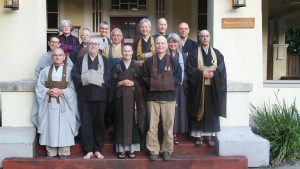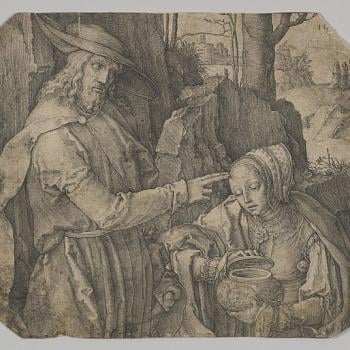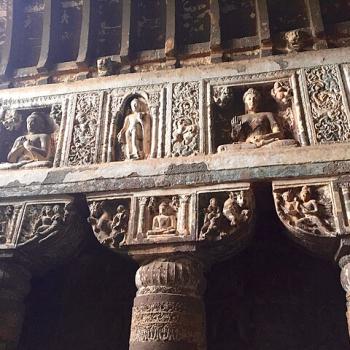The Zen Project in North America: A Small Progress Report
James Ishmael Ford
I started practicing Zen in 1969. I had a troubled heart, and I was on a quest for meaning and purpose.
I had a deep sense something was wrong. The world around me was chaotic, the terrible realities of our racially divided country were being held up to the world’s attention, we were embroiled in a war that seemed to have no real purpose, women were demanding to be treated like human beings, and clearly were not going to be silenced despite many people’s best efforts, there were real and painful divides between those with and those without, and, all this time the human population of the world was pushing beyond anyone’s idea of what the planet could sustain. And, really, all that revealed beyond any way I could ignore it, that there was something deeply wrong in the human world. For me digging deeper, I saw the religion of my youth as little more than a way of social control, for the most part only serving the status quo. And dipping into the political options, they all seemed either ineffective or crazy.
And that was simply the world around me. I knew as I tried to honestly look at myself that I was no exception to the vagaries of the human condition. My own heart was just as deeply troubled as the world I saw outside. And, this was the horrific part; I saw no obvious fixes. The god of my childhood looked simply like a projection of the human mind into the sky, creating a deity that I would not want to encounter in a dark alley. So, that seemed no route to a fix.
And at the same time I had some visceral sense there could be a way through. I realize this was not a rational thought. Possibly, probably it was just the deep human desire to survive, a drowning person’s fight to find air. But, whatever it is that drove me, I was driven, as driven as that drowning person. And intuitively it seemed the way through would be found in some way within religion, if not the religion of my childhood.
So, I tried a lot of things. And in the San Francisco Bay Area of the late 1960s, let me tell you, there were a lot of things to try. Fairly quickly on I discovered the Zen Center in San Francisco and began sitting at its branch in Berkeley. From there, well there was no turning back for me. People who want to know more about my particular path all you need do is google my name and “Zen.” More than I care to share is out there in the inter webs.
What is important here is that I have become a participant observer as Zen has been taking root in our Western soil. Here’s what I found.
Some two and a half millennia ago a man living on the boundaries of what today we call India and Nepal, born into privilege, but burning with many of the same questions that drove me, launched on a spiritual quest. He studied with the masters of his era, and finally gave himself over to a practice of presence. Out of that he had a life changing insight, not just for him, but for the world itself.
His personal concern was based in a belief that the human condition, that one I saw in my own life repeats in a literal way from one life to another. This has become an issue for many of us within modern world, mostly, although not exclusively in the West. But, the fascinating thing is that one need not believe in some post mortem reanimation for pretty much all of his observations about the human condition and the path out of the mesh of suffering to remain useful. That has proven a north star for me.
And then there’s Zen. When Buddhism arrived in China variations on the original teachings and path the Buddha outlined emerged. And of those one was Zen. (Okay, in China the word would be Chan – but, because of the way it unfolded in the West, we usually call it Zen) The word itself, Zen, Chan, Thien, Son, ultimately means meditation. And, that’s what was at the core of the Zen way, a meditation discipline, or, more correctly, a small basket of meditation disciplines. All of them in service to that insight which the Buddha proclaimed, and which is most succinctly presented in the line the Zen tradition says the wandering mendicant proclaimed upon his awakening, “the world and I wake up together.” That insight can also be called awakening. Sometimes it is called enlightenment.
There was one other critical element in the emergence of Zen. And that was a cadre of guardians of the insight and the disciplines. Traditionally the ownership of the way was the monastic order established by the Buddha. But in China something else emerged out of a response to a number of conditions unique to that culture. It was the myth of Dharma transmission, of a lineage of enlightened masters who extended right back to Gautama himself. What is important is that by sometime in the Eighth century that myth became a historical fact. And from that time on it has been impossible to extricate the Zen way from the transmitted teachers who stand in those lineages.
That said until very recently and almost exclusively in the West Zen’s lineage holders were also ordained clerics. In China and Korea and Vietnam they remained Vinaya monastics. In Japan with its own great shifts starting in the ninth century a new ordination model emerged based in the Bodhisattva precepts of the Chinese apocryphon the Bramajala Sutra, which eventually abandoned celibate and life long monasticism, although within the Zen school maintained a monastic experience, and for the teachers an extensive monastic experience.
Now, here in the West a number of things have come together to, first, make Zen appealing to many of us, and then for it to take root in a wild number of ways. The first most of us in North America heard of Zen was through the writings of Alan Watts. Watts was an enormously right person for the tumultuous 1960s. He was a long time student of Buddhism, and particularly of the scholar practitioner D. T. Suzuki. He took Suzuki’s interest in the Buddha’s insight understood through Zen, but for him as completely a-historical and not bound by any cultural expressions, and ran with it.
This was something just perfect for many of us. Me, included.
And then out of that some people traveled to Japan and other East Asian countries, and missionaries came from those countries. Significantly, most of those teachers were themselves eccentrics in their own countries, people who for different reasons were ready for something new. And, so, new we got.
The Vietnamese monk Thich Nhat Hanh offered his own social justice infused modifications of the Vietnamese Zen way. The Korean monk Seung Sahn offered a modification of his monastic training, including with it a blending of the huatou practice he had inherited in his Korean training modified through some years in Japan and an extensive exposure to the Japanese Rinzai koan tradition. The Chinese missionaries offered the fewest modifications of their way. The monk Hsuan Hua remained within the Chinese immigrant community, but through an aggressive publications program attracted a handful of Westerners, while the monk Sheng Yen actively embraced Western students coming to him.
But, it was the Japanese who captured the imagination and the largest numbers of Westerners interested in Zen and its ways. The Soto priests Soyu Matsuoka and most importantly Shunryu Suzuki both came West to serve Japanese and Japanese descent communities, actively embraced these new and mostly very young Western seekers. Critically Suzuki Roshi developed the idea of a “Zen center.” And modified the Japanese monastic training model in significant ways. Two other priests who came over to work with him and eventually began teaching independently Dainin Katagiri and Kobun Chino Otagawa each offered their own modifications of the Soto way. The British priest Houn Jiyu Kennett would add one more variation on the Soto way.
Rinzai had two principal expressions, one on the East coast led by Eido Shimano and in the West by Joshu Sasaki. Shimano offered a fairly close modification of the Japanese Rinzai model, but still a modification including an adapted version of the Rinzai koan curriculum. Sasaki also offered a modified but arguably even more intense monastic training model, although he largely abandoned koan introspection in its traditional Japanese style. Other Rinzai teachers had smaller impacts, Genki Takabyashi and Glenn Taylor Webb in Seattle, and other masters visited without settling in this country.
Taizan Maezumi, who came West in the same way as Matsuoka and Suzuki roshis, to serve Japanese communities settled in Los Angeles. He is wildly important for introducing a koan curriculum developed as a modification of the traditional Rinzai system by the turn of the last century Soto priest Daiun Harada. Also, Harada Roshi had authorized a teacher, Hakuun Yasutani who authorized lay teachers. And through Yasutani, who visited the West a number of times and attracted a number of people, the Americans Philip Kapleau and Robert Aitken would become the source of even more non-traditional Zen training.
Then came a wave of scandals. First it was revealed that Philip Kapleau did not have full authorization as a teacher. Then there were a series of sex scandals involving a long list of teachers, including most of the original teachers. And it didn’t stop. Many other teachers have since been implicated in scandals of varying degree. But, the net result was a shaking of the foundations. On the one hand Kapleau rosh was obviously a very good Zen teacher. And, what did it mean for the other teachers, the ones involved in sex scandals? What exactly was that insight is supposed to be if its guardians are often such sorry human beings?
Well, now, as I write these words in October of 2016, the dust seems to be settling, and we can cast eyes on what we see left.
Zen here is now a somewhat more modest offering. That great insight remains, but it is ever more understood as completely bound up with the stuff of this world and in no way separate from it. The need for an ethical component to the training has never been more obvious. And out of that some sense that systems of accountability are essential to the continuance of the project. At least some of us feel this. That the words “accountability” are said out loud also worry many, particularly as we have from Alan Watts forward had a significant part of us who are spiritual anarchists. Some hold on to the transmission itself as the sole qualifier for teaching, and others even deny that offering a Zenless Zen. But, the majority of those who have given their lives to the project do seem to feel a need for some kinds of accountability.
Exactly what and how remains unclear. Although the most obvious way is through the ordination model,the major way teachers emerge. For those for whom this is a central part of the corrections necessary to carry the Zen way forward there is little commonality within the details. Elsewhere I’ve identified five different models for the Soto school, the largest of the West’s Zen communities, that seem to be contending here.
In that reflection I didn’t even go into what may be the juiciest of the emergent and uniquely, or near uniquely Western expressions, and that is the lay Zen movements. The Harada Yasutani koan way opened the door. But, also among many of the Soto communities, particularly the lineages derived from Maezumi, fully independent lay teachers are guiding communities of practice. Other Soto lines have been more reluctant to let go of the priestly control, but through the obvious quality of many of their lay students have felt compelled to create forms of authorization that are less than full transmission. Whether these partial authorizations can hold these teachers back from eventually authorizing their own students is something of an open question.
Of course they face the same issues of “quality control,” and proper preparation for guiding others, but how they will do this is simply not established. Although there are some things we can see. Our teachers are more modest about who they are, and in general are more open to accountability. Critically, I think most of us who look honestly see that the training we get produces “journeymen” rather than masters, basically our teachers are practitioners who have at least some minimum preparation to guide others. The titles themselves are vastly inflated. Although, and this is important, I believe they are in the East, as well. Mastery, well, that’s an elusive thing. Some who might deserve such titles do appear to be emerging. But, only time shows. No titles do. This is a challenge, but also, I hope, a comfort. And hints at our way through.
Styles of training continue to be wildly over the map. They range from extremely harsh disciplines, to no disciplines at all. One group, the Soto Zen Buddhist Association, is trying to create expectations for its members, but at this time is deeply divided over what they should be. The other large organization, the American Zen Teachers Association, does everything it can to not be an arbiter of quality, and wishes only to be a support group. A third group, the Lay Zen Teachers Association, has recently emerged to serve the lay teachers only, and it seems to be following the pattern of the support group. And a significant number of teachers with various claims to standing within the traditional lineages would have nothing to do with any organization.
And, also, we are at the edge of what I am fond of calling “the great die-off.” The boomer generation dominates the Western Zen scene. Twenty years ago I even began to fear Zen was merely a boomer thing. But, I’ve been heartened to see that Gen X and especially the Millennials have begun to take an interest in the Zen dharma. But, within twenty or so years, there will be a considerable contraction, possibly by as much as eighty percent. And, what will be left, well, that’s a wildly open question.
And that’s us, in the moment.
We are the inheritors of great gifts. We have modified the containers for those gifts. We are still doing so. Hopefully we have not, and are not throwing out the baby.
Me, I don’t think so. I have a sense that something of value will continue. It may not be the shape I want, but that doesn’t matter. What we know for sure is that somewhere in the country it is possible to find people offering instruction and guidance in Zen meditation, along with forms of monastic training, intensive retreats, and koan introspection. At some places all of these. All around the country there are people who have given their lives to the disciplines, and who have been authorized in that ancient lineage to continue it. And, yes, there are those who haven’t a clue regarding what they’re about including both many who have trained, and, some who once walked in the general direction of a training community and caught a title the way some people catch a cold. And just because the universe enjoys a good joke, one or two of those who have a title without much else by way of training, are actually quite good Zen teachers. In my view. We are in a time of a hundred flowers. And, as always, caveat emptor.
What I am confident of is that the great way continues. The saddnesses of life, its essential tragic nature is still with us. The divide of rich and poor, very much right here, but even more so that divide between our all devouring Western cultures and the striving majority of the world threatens the heart of humanity. War and rumors of war are joined by the eternally arising poisons that manifest as racism, sexism, fear of any other, of which it turns out there are many. The human population of the globe expanded past what anyone believed was sustainable quite a while ago. And, we may even have passed a tipping point for poisoning the world.
And those are just the external problems. The world is filled with a great sorrow.
And. And, the great sorrow is being addressed. Whatever the precise shape, the wonderful ways of healing that Zen presents, perhaps even better for the battering it has taken as a way, and in its more modest forms will continue to be offered. Right through to the end. Whether hospital or hospice, this way is the great gift of the cosmos to our human family. And it continues.
Of that, I am sure.
Many bows.













